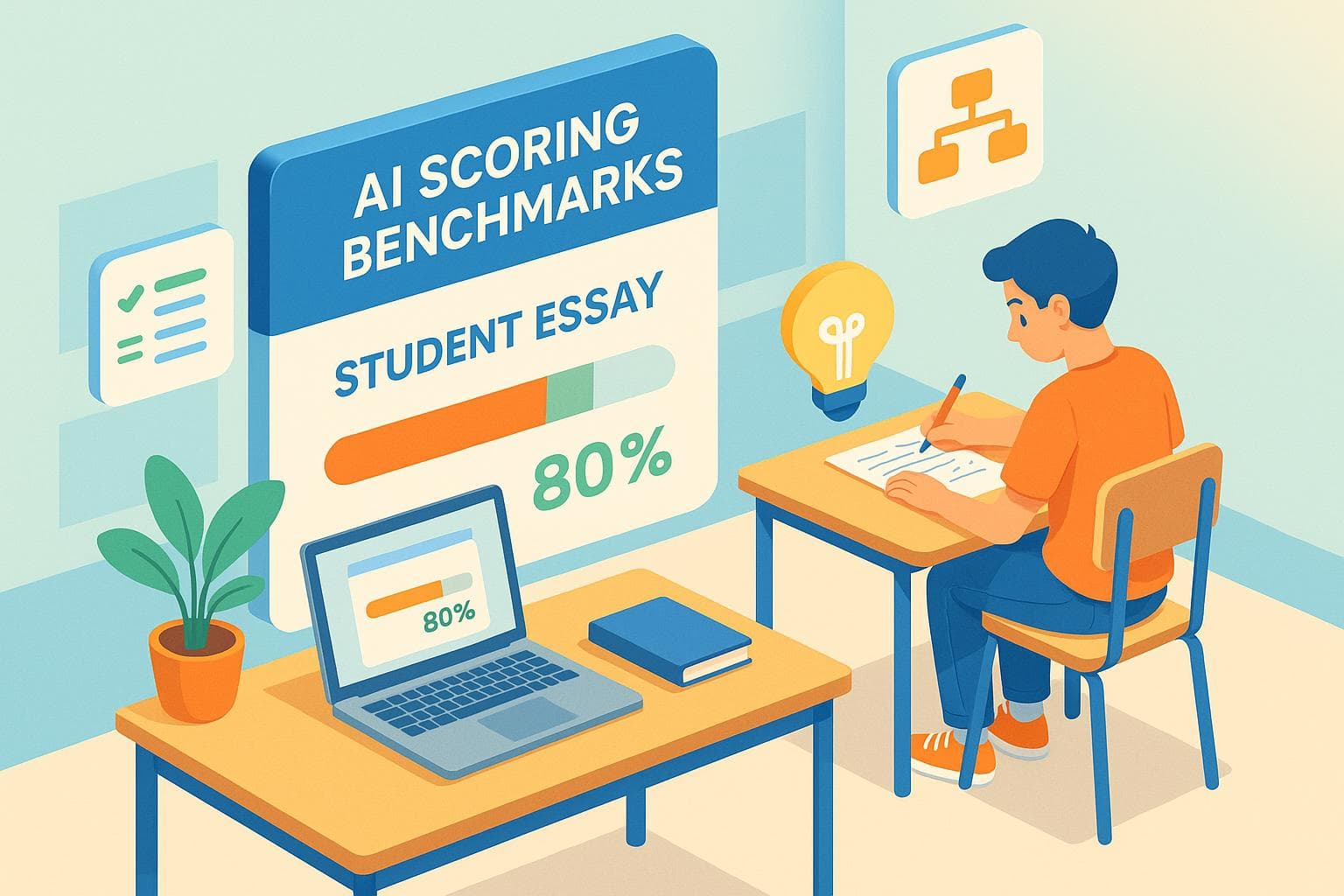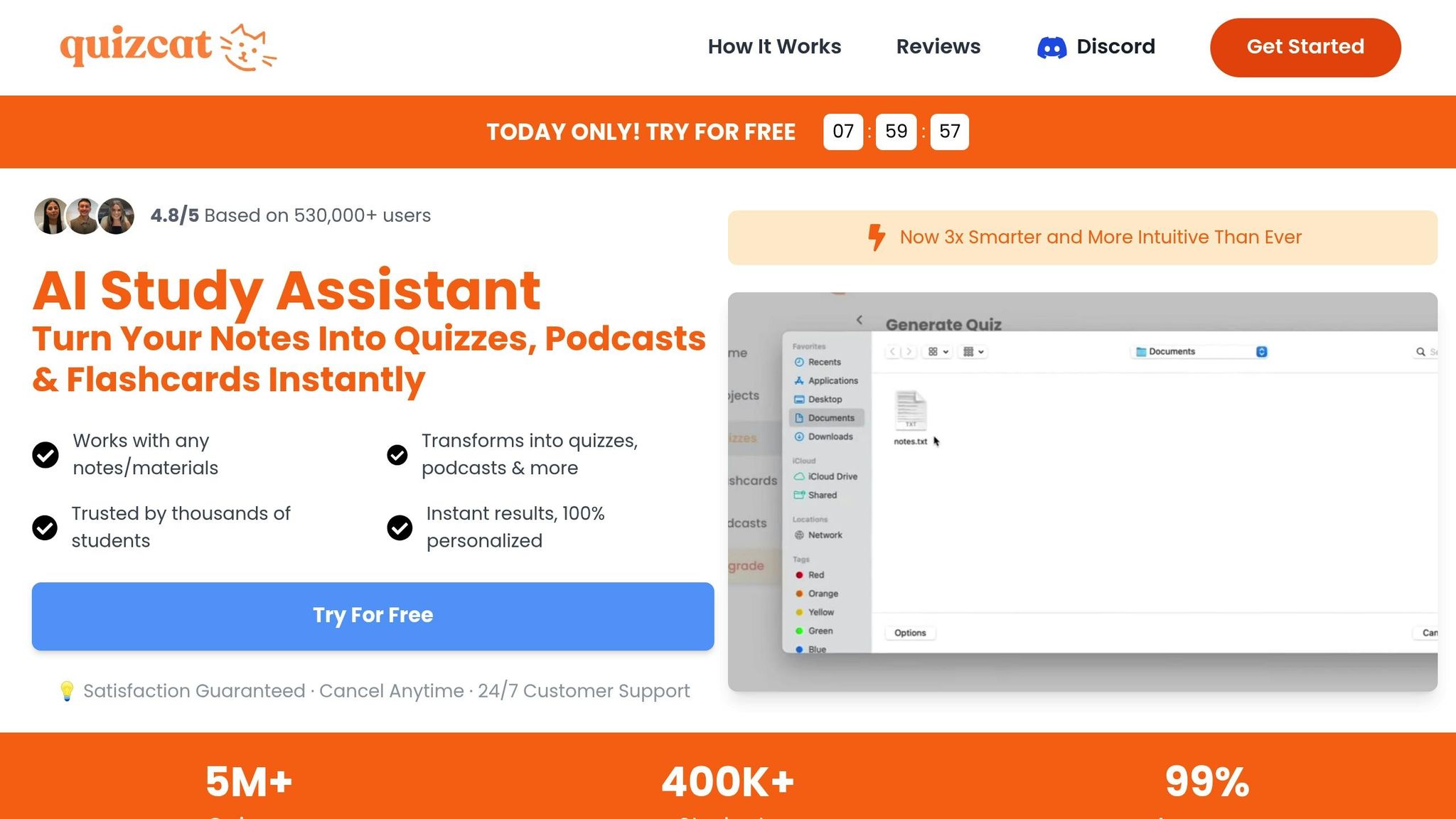
AI Scoring Benchmarks: What Students Should Know
AI scoring systems are reshaping how essays are graded, offering faster feedback and consistent evaluations. Here's what you need to know:
- AI aligns with human grading: AI scores match human graders 89% of the time for general essays, 83% for English papers, and 76% for history essays.
- What AI evaluates: Grammar, organization, argument strength, and evidence usage are key focus areas.
- How students benefit: Immediate feedback helps you improve writing skills by targeting specific areas like structure and technical accuracy.
- Challenges: AI struggles with nuanced aspects like creativity and deeper analysis, making teacher feedback equally important.
Automated Essay Scoring with AI: A Brief Introduction
Creating AI Scoring Standards
AI scoring systems are designed to evaluate writing with the consistency and fairness of human graders. Leading educational assessment organizations use rigorous methods to ensure these systems provide reliable feedback.
Building from Human Grades
The foundation of AI scoring lies in data from human-graded essays. Researchers compile thousands of essays that have been evaluated by experienced educators to create a "ground truth" for the AI to learn from. For instance, a recent benchmark included over 10,000 essays with nearly 100,000 graded solutions. These systems are trained to assess various dimensions of writing, such as:
| Writing Dimension | What AI Evaluates |
|---|---|
| Technical Elements | Grammar, syntax, and vocabulary usage |
| Content Quality | Strength of arguments and use of evidence |
| Organization | Logical flow and paragraph structure |
| Assignment Fit | Adherence to specific requirements |
Training AI on subject-specific datasets is crucial. For example, general essay scoring achieves an 89% agreement between AI and human graders, but this drops to 83% for English papers and 76% for history essays. These dimensions form the groundwork for testing the accuracy of AI scoring systems.
Testing Score Accuracy
To ensure these systems work reliably, educational technology companies use thorough validation methods. Benchmark Education, in partnership with AWS, has developed a structured approach to test AI grading tools in real classroom settings. Some of the key methods include:
-
Cross-Validation Testing
In this method, educators grade essays independently without seeing the AI-generated scores, while the AI evaluates the same essays in a blind test. This helps confirm how closely the AI aligns with human grading. -
Demographic Fairness Analysis
Developers use bias detection algorithms to check whether the AI scoring system treats all student groups equitably. Essays from a wide range of backgrounds and writing styles are analyzed to ensure fairness.
While AI scoring systems perform well at assessing large groups, achieving precise accuracy for individual essays remains a challenge. Regular updates - such as refining training datasets and adjusting algorithms based on educator feedback and new research - help these systems stay aligned with academic standards as they evolve.
Main Scoring Measurements
AI essay scoring systems rely on specific metrics to evaluate student writing, offering varying levels of accuracy depending on the type of assignment. Understanding these metrics can help students tailor their work to meet the expectations of AI evaluation systems.
Comparing AI vs Human Scores
AI scoring systems are designed to align closely with human grading benchmarks, providing a reliable alternative for evaluating essays. Research shows that AI scores fall within one point of human scores in 89% of general essays, 83% of English papers, and 76% of history essays. These findings indicate no significant difference in population averages between AI and human grading. For instance, an analysis of over 10,000 competitors and nearly 100,000 solutions further confirms AI's consistency in handling large datasets.
Writing Elements Measured
AI systems evaluate essays by analyzing various aspects of writing through natural language processing algorithms. These systems assess both technical and conceptual components, as outlined below:
| Element Type | Measurements | AI Accuracy Level |
|---|---|---|
| Technical Skills | Grammar, punctuation, sentence structure | High |
| Organization | Logical flow, transitions | Medium-High |
| Content Analysis | Evidence usage, argument strength | Medium |
| Higher-Order Thinking | Creative reasoning, original analysis | Medium-Low |
AI tools excel at evaluating technical elements like grammar and sentence structure but face more challenges with subjective or nuanced aspects, such as creative reasoning. For instance, history essays - often requiring deeper context and causation analysis - tend to show lower agreement rates between AI and human graders.
To address these challenges, companies like Benchmark Education are working on tools that aim to maintain high accuracy while significantly reducing grading time. This allows teachers to dedicate more energy to direct interactions with students. These insights enable students to identify areas for improvement and align their writing with the criteria used by AI scoring systems.
sbb-itb-1e479da
Student Writing Tips for AI Scoring
By understanding how AI scoring systems evaluate essays, students can align their work with these benchmarks while honing their authentic writing skills.
Meeting AI Scoring Requirements
AI scoring systems assess essays based on consistent, measurable criteria. To meet these standards, focus on the following key elements:
- Clear structure: Start with a strong thesis statement and use topic sentences to guide each paragraph.
- Technical precision: Pay attention to grammar, punctuation, and syntax.
- Evidence-based arguments: Support claims with relevant facts and proper citations.
- Logical organization: Ensure smooth transitions between paragraphs for a cohesive flow.
| Writing Component | Key Focus Areas |
|---|---|
| Structure | Clear thesis and topic sentences |
| Technical Elements | Grammar, punctuation, and syntax |
| Evidence Usage | Supporting facts with citations |
| Organization | Logical flow and transitions |
To achieve higher scores, avoid common pitfalls like unsupported claims, straying off-topic, grammatical mistakes, or overly formulaic writing. AI scoring systems are designed to align closely with human graders, often differing by no more than one point on a six-point scale. This makes consistent technical accuracy a must.
Practice with QuizCat AI

Students can sharpen their writing skills using tools like QuizCat AI, which offers tailored resources to target key areas of improvement. Features include:
- Quizzes that focus on essential writing concepts.
- Flashcards to reinforce grammar rules and writing techniques.
- Audio lessons created from drafts for easy review.
With instant feedback and actionable insights, QuizCat AI helps students pinpoint weaknesses and improve. The platform's popularity speaks for itself, boasting over 400,000 users and a stellar 4.8/5 rating.
Combining AI and Teacher Feedback
While AI tools excel at analyzing technical aspects, teacher feedback is invaluable for assessing argument depth and creative expression. A balanced approach to feedback can lead to more holistic improvement:
- Use AI scores to refine grammar, structure, and organization.
- Analyze teacher comments to strengthen argument quality and creativity.
- Compare both sets of feedback to identify specific areas for growth.
- Apply the combined insights to future essays for continuous improvement.
This dual-feedback method ensures students not only meet AI scoring standards but also develop richer, more nuanced writing abilities.
Summary: Benefits of Understanding AI Scoring
Grasping how AI scoring works can help students write more effectively and improve their grades. AI scoring systems align with human evaluations within one point 89% of the time. This alignment makes it easier to integrate fast AI feedback into daily writing practices.
Faster Feedback for Better Progress
AI grading tools can cut feedback time by as much as 80%. With quicker feedback, students can identify and address issues faster, speeding up their learning process. This efficiency works alongside traditional grading methods, making revision cycles much quicker.
Improved Focus on Key Writing Skills
When students understand AI scoring benchmarks, they can better target areas like organization, grammar, and evidence use - key factors valued by both AI and human graders. However, studies show that evaluations can differ, particularly for creative or nuanced writing.
Interactive Tools for Practice
Tools like QuizCat AI simplify learning by offering interactive quizzes, instant feedback, and personalized study materials, all designed to help students strengthen their writing skills.
Blending AI and Teacher Feedback
Using a combination of AI-generated insights and teacher guidance creates a balanced approach to improving writing. This prepares students to excel across various types of assessments.
FAQs
How do AI essay scoring systems ensure fairness and accuracy for all students?
AI essay scoring systems aim to provide an impartial evaluation of student work by leveraging extensive datasets to train their algorithms. These datasets incorporate a wide range of writing samples, enabling the AI to identify and assess diverse writing styles, vocabulary choices, and grammar usage.
To uphold fairness across various student demographics, developers continuously test and fine-tune these systems to reduce biases tied to language, cultural differences, or personal backgrounds. By regularly updating the models and comparing their performance to human scoring standards, developers work to ensure consistent accuracy. This approach helps guarantee that students are judged solely on the quality of their writing, without influence from external factors.
What writing skills can help students achieve better scores on AI-graded essays?
AI essay scoring systems typically assess essays by examining key elements like clarity, organization, grammar, and vocabulary usage. To achieve higher scores, focus on crafting essays that are well-structured, starting with a clear introduction, followed by coherent body paragraphs, and ending with a strong conclusion. Pay attention to your language - be precise and double-check your work for grammatical errors through careful proofreading.
It's also important to ensure your arguments are logical and backed by relevant evidence. These systems appreciate variety in sentence structure and word choice, so mix up your sentence types and steer clear of repetitive phrasing. By refining these aspects of your writing, you can not only improve the overall quality of your essays but also boost your AI-generated scores.
How can students use AI feedback and teacher guidance together to improve their writing?
To take your writing to the next level, blend AI feedback with input from your teacher. AI tools are great for catching grammar errors, suggesting clearer phrasing, and pointing out ways to improve structure. Teachers, on the other hand, bring a human touch - offering advice on tone, creativity, and subject-specific details that AI might overlook.
Start by using AI to tackle the technical side of your writing - things like grammar, sentence flow, and formatting. Once that's polished, sit down with your teacher to focus on elements like the strength of your arguments, originality, and overall clarity. By combining the strengths of both, you can sharpen your writing skills and produce more polished, impactful work.
